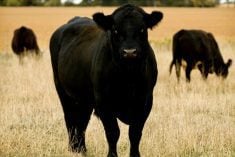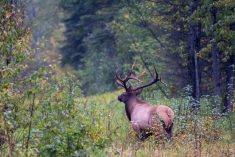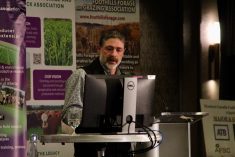Anthrax spores can lurk in soil for decades and there’s no telling where the disease will pop up from year to year. All it takes is something that brings spores to the surface and the stage is set for an outbreak in cattle that happen to ingest them.
Predicting when anthrax will occur in Canada is fairly predictable though. Provincial departments of agriculture and their chief veterinary officers generally recommend vaccinating livestock before turning them onto pastures in regions where anthrax deaths have occurred in the past. Announcements to be on the watch for signs of the disease are common as daytime temperatures rise into the 20 C range from early summer to early fall. Cases outside that time frame are usually traced to anthrax spores in dust on feedstuffs from contaminated fields.
Read Also

What to know before you go to Agribition 2025
If you’re attending Agribition 2025, this is the place to find out about tickets, dates and what’s happening this year.
According to the Beef Cattle Research Council’s (BCRC) anthrax fact sheet, the “perfect storm” for an anthrax outbreak is a heavy rain or flooding in spring to bring spores to the surface and a drought later on that causes cattle to graze close to the ground and pick them up, but either a drought or a flood is enough to increase the presence of spores.
Spores can be ingested in soil particles, from dust on plants or by drinking standing water where spores concentrate. Wind and water erosion, excavation for pipelines or water sources, or even deep tillage of cropland for annual forage crops can also expose anthrax spores.
BCRC reports that the most significant outbreak in Canada was in 2006. It took more than 800 animals on more than 150 premises in Saskatchewan and Manitoba. A follow-up study in Saskatchewan concluded that farms where outbreaks occurred had higher levels of flooding, wetter pastures, shorter pasture grass length, and higher density of animals in a pasture. It also found that the timing of vaccination after the first observed case in a rural municipality (in cattle herds that were not previously vaccinated) affected herd survival rate. As can be expected, the sooner that herds were vaccinated, the lower the death loss on a farm.
The period between ingesting the spores and their germination to produce anthrax bacteria that release the deadly toxins is approximately seven days and then death comes quickly, often within hours. The first sign of anthrax is usually sudden death of otherwise healthy cattle.
The second telling clue is blood or bloody fluid oozing from body openings and an absence of rigor mortis because the blood doesn’t clot properly.
This is anthrax bacteria’s survival mechanism. They need oxygen to advance to the spore state and once again be stable in the environment.
Remembering that all tissues are likely to be infected in animals that die from anthrax, it’s important to prevent the spread by leaving the carcass where it lies and securing a tarp over it to prevent scavenging. Although birds aren’t susceptible and carnivores are highly resistant to anthrax, both can disperse infected tissues across great distances.
Contact your veterinarian to take and submit samples to a lab to confirm the diagnosis, discuss vaccination and/or antibiotic treatment, and how to burn the carcass to destroy the bacteria. Deep burial is an alternative in locations where burning isn’t an option.
The Canadian Food Inspection Agency stopped becoming involved with anthrax investigations as of April 2013; however, the disease remains on the list of federally reportable diseases. Provinces now have their own anthrax response plans to advise producers and their veterinarians on reporting and handling an outbreak.
Producers are generally responsible for all costs related to farm visits by their veterinarians, vaccines and medications, and carcass disposal. Some provinces cover the cost of the initial lab test to confirm the diagnosis. Saskatchewan, for one, places short-term movement restrictions on the herd until seven days after the last death and reimburses the veterinarian for farm visits to ensure proper carcass disposal and to apply and remove the movement restrictions.
For more information go to www.beefresearch.ca, or your provincial agriculture website.
















